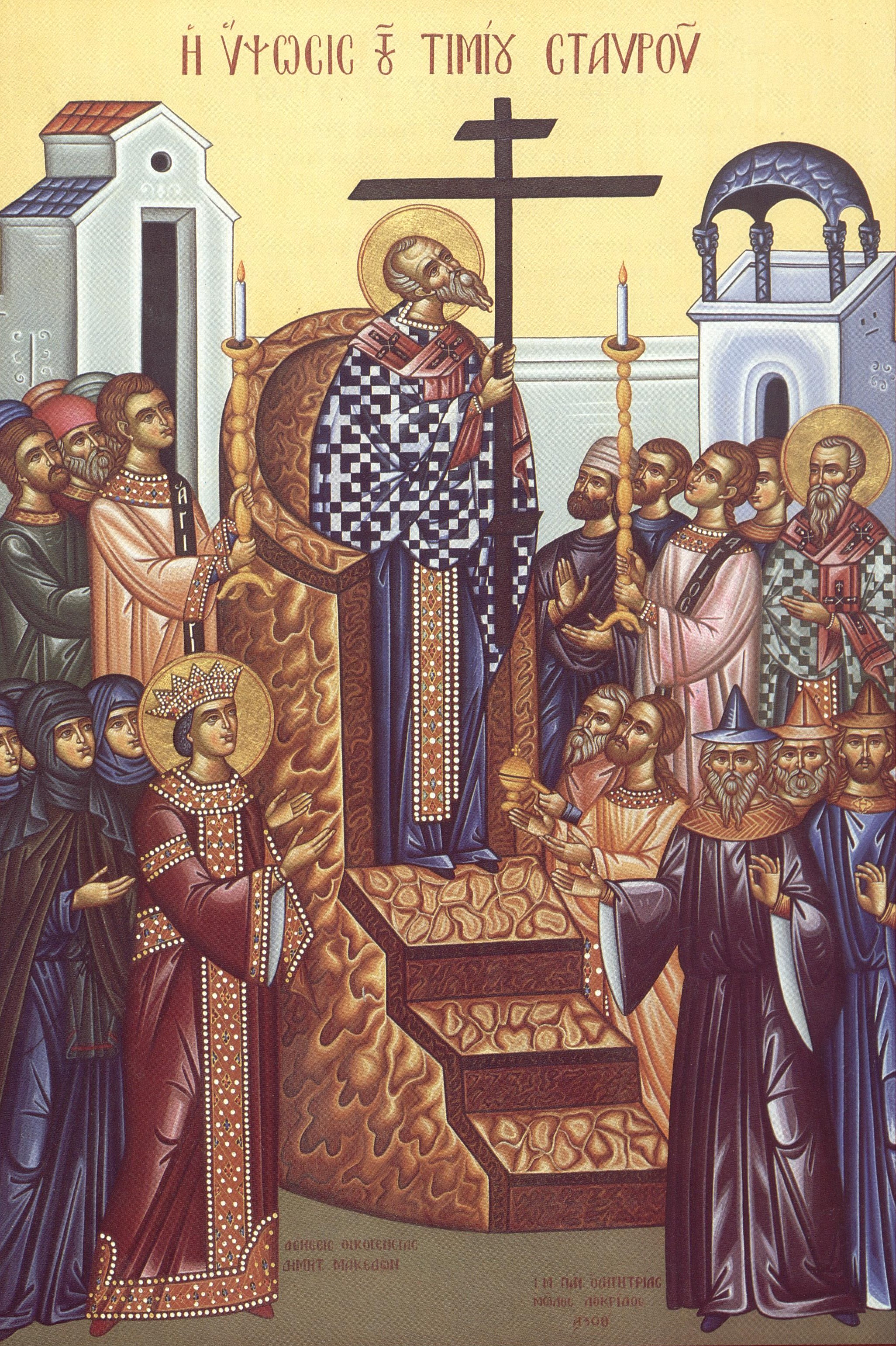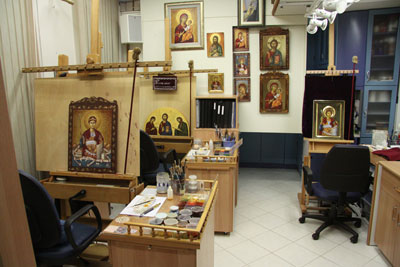Translated excerpts from the book:
Στεργίου Ν. Σάκκου [Read CV], Ὁ Σταυρός στό φῶς τῆς Ἀνάστασης, ἐκδ. «ΧΡΙΣΤΙΑΝΙΚΗ ΕΛΠΙΣ» ΟΡΘΟΔΟΞΗ ΑΔΕΛΦΟΤΗΤΑ, Θεσ/νίκη 2019
 The universal Exaltation of the Precious Cross (September 14) proclaims the rejoicing of the whole created world, the redemption and happiness of every believer. It signifies what is most joyful and good—indeed, it conveys what the very word “gospel” means.
The universal Exaltation of the Precious Cross (September 14) proclaims the rejoicing of the whole created world, the redemption and happiness of every believer. It signifies what is most joyful and good—indeed, it conveys what the very word “gospel” means.
Yet, when we look back through history, we see that in the time before Christ the cross carried a completely different, dreadful, and terrifying meaning. It was the instrument of the most painful and shameful condemnation, the symbol of the dominion of evil, the curse, the banner and the trophy of the devil. No one could have dared—not only to assert, but not even to conceive—a connection or kinship of the cross with anything good and joyful.
How then did this inconceivable change take place—the transformation of the cross and its identification with the gospel? This unimaginable achievement is the work of the love, the wisdom, and the power of God. With a bold leap, God descends from heaven into the earth, into the realm of the “ruler of this world,” and seizes his dominion. He shatters his kingdom and sets free the captives held in bondage to Satan. As Jesus Christ is lifted up as the last of the condemned on Golgotha, He accomplishes the complete crushing of the adversary, the devil. The apostle Paul records in simple words the offering of Jesus Christ through the cross: “When he ascended on high he led a host of captives” (Eph 4:8). He made the captives of the ruler of this world His own, and as Lord He now raises the cross as His banner, His own flag. The God-man is now the Victor!
Of course, the above holds true only for those who confess Jesus Christ as God and accept to cooperate with Him through repentance. For the others, who willfully remain far from Christ and from His redeeming work, all this is meaningless. It is understandable, then, that they fill their daily lives with countless other symbols, while at the same time opposing and seeking to abolish the symbol of the cross.
Jesus Christ reveals to the world the cause of joy, the gospel, the blessed secret of God. It is the cross! Yes, the cross that is accompanied by pain, suffering, blood, and death. The gospel does not mean merely good words or moral teaching. It signifies the event of Jesus Christ, the condescension of God, who descends to earth in order to experience pain in its most agonizing form; He endures a series of humiliations, so that He might be nailed upon the cross as “obedient unto death, even death on a cross” (Phil 2:8). All of this, along with the teaching and preaching of Jesus Christ, is what Paul refers to as the gospel of glory. The truths of the gospel shine forth and illumine the world, and their light reveals the inexhaustible light, the Sun of Righteousness, the incarnate God, whose life is marked by the cross. For this very reason the cross is no longer disgrace and curse, but honor and glory, resurrection.
Of course, in the apostolic age the gospel had not yet taken shape as the written book we know today, nor had the cross yet come to prevail as a visible sign. This came later, when the body of the twenty-seven books of the New Testament was compiled, and correspondingly the symbol of the cross was established. Thus, when the holy apostles speak of the gospel, they mean the event of salvation. Likewise, they call the cross the crucified Lord.
Cross and gospel are identified as two sides of the same coin. The apostle Paul experiences this in a very practical way, for the gospel (see Rom 2:16) is his daily concern and the breath of his life, while at the same time he bears in his body “the marks of the cross” (cf. Gal 6:17). And our holy Church bears witness to this in visible form through the holy Gospel, which rests upon her sacred altar; on the one side it bears the cross, and on the other the resurrection. In this way it shows that the fearful suffering of the cross is the guarantee of the supreme joy of the resurrection.
This must be especially emphasized in our pleasure-seeking age, which absolutely rejects the cross or deceitfully distorts its essence; in every way it seeks to make our life painless, carefree, and free from all suffering. For this reason, today more than ever, we are unfamiliar with and untouched by true joy. Joy remains inaccessible, and the gospel fruitless and of no benefit, when the cross is “emptied,” when it loses its content. And what is the content of the cross? It is Christ Himself, His gospel. On the cross, as on a hard disk, the entire life and offering of the God-man is stored. When the Christian becomes alienated from this, he empties the Cross. The practical implications of this I will present with a series of images.
◆ The cross is the rod and the staff, our support for a secure journey along the way of God. With its strength we carry out the will of the Lord willingly and joyfully, and then “his commandments are not burdensome” (1 Jn 5:4). Without the cross, they seem impossible to us.
◆ The cross is the elevator that lifts us into the glory of God; if the elevator breaks down, we will never ascend, never experience the joy of the gospel.
◆ The cross is the umbrella that shields us from the rain of the devil; if the umbrella is pierced, it loses its protective function, and with it the joy of Christ disappears from our life.
◆ The cross is the cloak that warms us with the love of God. Without its help, unbelief chills us.
◆ The cross is the treasury that contains the precious treasure of our salvation, the vessel of myrrh in which is stored the “inexhaustible myrrh,” the “fragrance of Christ.” If we empty the treasury or the vessel of myrrh, it is of no benefit to us.
◆ The cross is a “weapon against the devil,” the missile with which we crush him. But if the missile remains unused, or if through clumsy handling it explodes in our hands, our very life is endangered. This is what happens when we do not make the sign of the cross correctly.
The cross of Christ, stained with His immaculate blood and illumined by His glorious Resurrection, stands as the decisive crossroads where two paths meet: the road to heaven and the road that leads to the ends of the earth. With the unshakable foundation of Jesus Christ, the cornerstone upon which the Church is built, the faithful overcome the attraction of the world; “they take part in everything as citizens, and they endure everything as strangers.” At the same time, they embrace all people with a love unknown and without precedent, a love whose distinguishing mark is sacrifice. This is precisely what the commandment of Christ means: “Love one another as I have loved you” (Jn 13:34). Here lies the crucial point, where the great danger lurks: as love spreads out to all, it must not wrong the holy foundation, must not empty the cross of Christ, must not distort the Orthodox faith.
Just as Jesus Christ, “without departing from His nature, partook of our human substance,” Christ became man without ceasing to be God, so also we must love everyone—yet without falsifying the faith, without defiling the doctrine, without being moved away from the foundation of the cross. Then we truly honor it and partake of the joy that the cross has poured out upon the world; we enjoy the gifts that He bestows upon our life.









